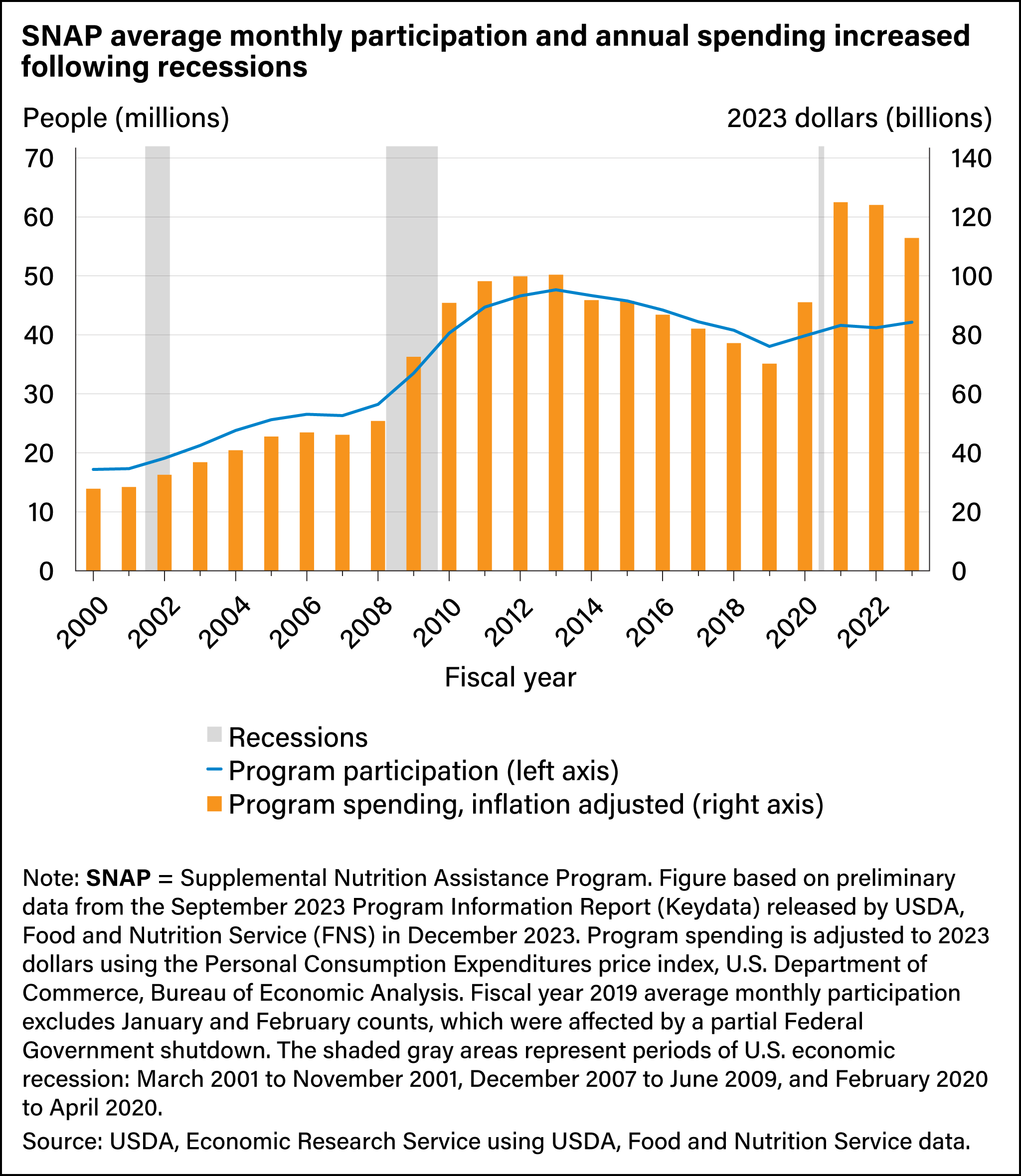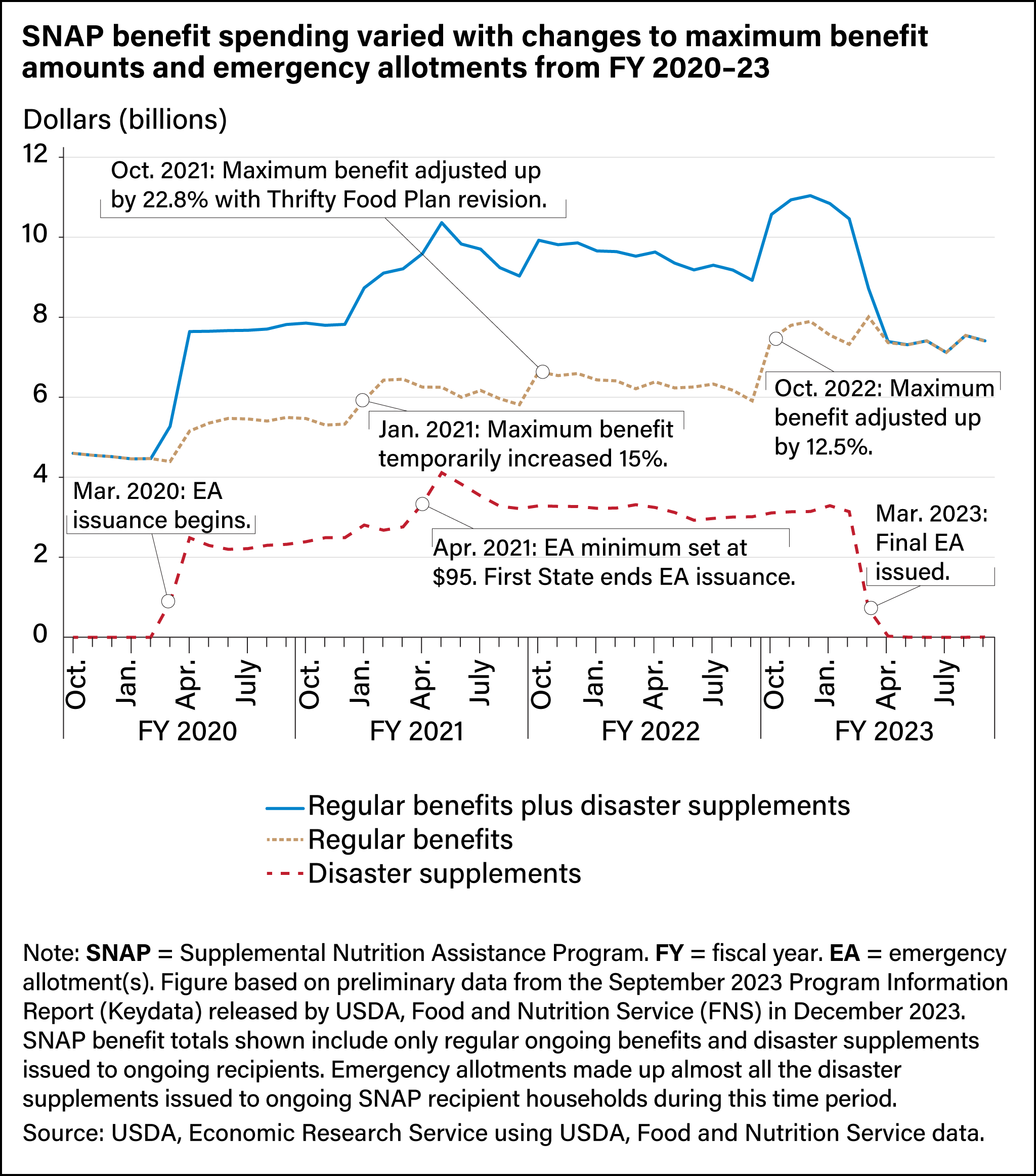
SNAP Spending Rose and Fell With Pandemic-Era Changes to Benefit Amounts
- by Jordan W. Jones
- 6/12/2024
USDA’s Supplemental Nutrition Assistance Program (SNAP), which provides benefits for low-income households to buy groceries, is the Nation’s largest nutrition assistance program and USDA’s largest program by spending. In fiscal year (FY) 2023, 42.1 million people received SNAP benefits per month, on average, amounting to 12.6 percent of the U.S. resident population. Federal spending on SNAP totaled $112.8 billion in FY 2023, or 67.8 percent of total USDA domestic nutrition assistance spending that year.
SNAP eligibility and benefit size are means-tested, so when net household income falls such as with a job loss, households may become eligible and/or receive larger benefits. This means SNAP participation and spending historically have grown following economic recessions. In past economic downturns, policymakers have temporarily expanded the program to alleviate hardship and stimulate the economy. For instance, maximum benefits were increased by 13.6 percent in response to the Great Recession from 2009–13. Increased participation from FY 2007 to 2013 along with policy responses led to a prepandemic spending peak of $100.4 billion in FY 2013, adjusted for inflation to 2023 dollars.
From FY 2020 to 2023, during the Coronavirus (COVID-19) public health emergency, SNAP participation also increased, but not enough to wholly account for the sharp increase in spending in FY 2020 and 2021. The spending change during this period is largely attributable to three increases to maximum benefit amounts and the issuance of emergency allotments. In January 2021, maximum benefits were temporarily increased through June 2021 by 15 percent of the initial FY 2021 amounts. This was later extended through September 2021. The monthly cost of regular ongoing benefits increased from about $5.3 billion in December 2020 to $6.4 billion in February 2021. Then, maximum benefits were permanently increased by about 23 percent above FY 2021 levels in October 2021 following the June 2021 Thrifty Food Plan revision. However, the actual increase from September 2021 benefit levels was smaller because of the expiration of the temporary 15-percent increase. Spending on regular SNAP benefits increased from $5.8 billion in September 2021 to $6.6 billion in October 2021. Finally, high food inflation resulted in a larger-than-average inflation adjustment the following year of 12.5 percent. Regular benefit spending subsequently increased from $5.9 billion in September 2022 to $7.5 billion in October 2022.
In addition to maximum benefit changes, States issued temporary emergency allotments during the pandemic public health emergency to supplement household benefits. At first, emergency allotments were sized to “fill in” the gap between a recipient household’s maximum possible benefit and their regular benefit, meaning all households would receive the maximum benefit regardless of net income. Monthly issuance began in most States in March or April 2020. In April 2020, spending on disaster supplements—almost all of which were emergency allotments during the public health emergency—totaled $2.5 billion. In April 2021, USDA altered emergency allotments so that recipients would receive at least $95 per month in addition to regular benefits, allowing some households to exceed the maximum regular benefit. Following this change, the monthly cost of disaster supplements peaked at $4.1 billion in May 2021. From April 2021 through the end of September 2022, 17 States stopped issuing emergency allotments. Monthly disaster supplement issuance fell to about $3.1 billion by October 2022. South Carolina ended emergency allotments after the January 2023 issuance, and the remaining States, Washington, DC, and territories ended them after the February 2023 benefit (issued in February or March depending on issuance schedule). By April 2023, disaster supplement spending dropped to negligible amounts. Overall, during the period from April 2020 through February 2023 in which emergency allotment issuance was in effect, spending on regular SNAP benefits and disaster supplements averaged $8.9 billion a month, with emergency allotments and other minor disaster supplements accounting for 28 percent.
Together, these benefit increases explain a large part of increased SNAP spending in the period after the pandemic’s onset in 2020. Total benefit spending fell in FY 2023 alongside the expiration of the Federal public health emergency in May 2023 and the end of emergency allotments but remained above spending levels before the pandemic. By FY 2023, the maximum regular benefit for a family of four was $939 per month—45 percent higher than the maximum of $646 per month in FY 2020.
This article is drawn from:
- Jones, J.W. & Toossi, S. (2024). The Food and Nutrition Assistance Landscape: Fiscal Year 2023 Annual Report. U.S. Department of Agriculture, Economic Research Service. EIB-274.
You may also like:
- 2025 Farm Bill - Recent Farm Bill-Related Research. (n.d.). U.S. Department of Agriculture, Economic Research Service.
- Jones, J.W., Jones, K., Leschewski, A.M. & Melo, G. (2024, April 16). SNAP Online Purchasing Pilot Reduced Food Insufficiency Among Low-Income Households During Early Pandemic. Amber Waves, U.S. Department of Agriculture, Economic Research Service.
- Supplemental Nutrition Assistance Program (SNAP). (n.d.). U.S. Department of Agriculture, Economic Research Service.
- Food & Nutrition Assistance. (n.d.). U.S. Department of Agriculture, Economic Research Service.
- Jones, J.W. & Toossi, S. (2023, August 21). U.S. Food and Nutrition Assistance Programs Continued To Respond to Economic and Public Health Conditions in Fiscal Year 2022. Amber Waves, U.S. Department of Agriculture, Economic Research Service.
We’d welcome your feedback!
Would you be willing to answer a few quick questions about your experience?



